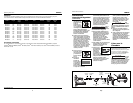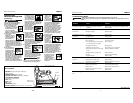
Cómo usar la
Clavadora (Continuación)
1. Desconecte la
clavadora de la
fuente de sum-
inistro de aire
para lubricarla.
2. Gire la clavadora de
modo que la entrada
de aire quede miran-
do hacia arriba.
Agregue de 4 a 5
gotas de aceite sin
detergente 30W en la entrada de
aire. No use aceites con deter-
gentes, aditivos de aceite, ni aceites
para herramientas neumáticas. Los
aceites para herramientas neumáti-
cas contienen solventes que pueden
averiar los componentes internos de
la clavadora.
3. Después de agregar
aceite, haga fun-
cionar la clavadora
brevemente. Limpie
todo exceso de
aceite que salga del escape de la
tapa.
CONEXION RECOMENDADA
La ilustración de abajo le muestra la
conexión recomendada para la
clavadora.
1. El compresor
de aire debe
tener la capaci-
dad de suminis-
trar un mínimo
de 4,14 bar
cuando la clavadora esté en uso. Si
el suministro de aire es inadecuado
podría haber pérdida de potencia y
falta de consistencia en el fun-
cionamiento.
2. Puede utilizar un
lubricador para
lubricar la clavado-
ra. Igualmente,
puede utilizar un
filtro para remover
las impurezas líquidas y sólidas que
podrían oxidar u obstruir las partes
BUILT TO LAST
elemento de contacto antes de cada
uso. El elemento de contacto se debe
desplazar libremente, sin pegarse, a lo
largo del área de desplazamiento. El
resorte del elemento de contacto debe
regresar el elemento de contacto a su
posición original totalmente extendido.
No use la clavadora si el mecanismo del
elemento de contacto no está funcio-
nando adecudamente. Podría ocasion-
arle heridas.
1. Desconecte la
clavadora de la
fuente de sum-
inistro de aire.
2. Saque todos los
clavos del car-
gador (Vea la
Sección Carga-
Descarga).
3. Cerciórese de que el
gatillo y el elemento
de contacto se mue-
van libremente en
ambos sentidos sin
atascarse o pegarse.
4. Reconecte la
clavadora a la
fuente de sumin-
istro de aire.
5. Presione el
Elemento de
Contacto de
Trabajo contra la
superficie de traba-
jo sin apretar el gatillo. La clavadora
NO DEBE OPERAR. No use la her-
ramienta si opera sin apretar el
gatillo. Se pueden producir lesiones
personales.
6. Remueva la clavado-
ra de la superficie de
trabajo. El Elemento
de Contacto de
Trabajo tiene que
volver a su posición original. La
clavadora NO DEBE OPERAR. No
use la herramienta si opera mien-
tras está levantada de la superficie
de trabajo.
internas de la clavadora.
3. Use siempre mangueras de
suministro de aire, con una presión
mínima de funcionamiento con
clasificación igual o mayor que la
presión de la fuente de energía si
falla un regulador, o 10,34 bar, lo
que sea mayor. Use mangueras de
aire de 9,5 mm (3/8") para distancias
de hasta 15 m (50’) ó más. Para un
mejor rendimiento, instalele a la
clavadora un conector rápido de
9,5mm (3/8”) (con roscas de 6,4mm
(1/4”) NPT) cuyo diámetro interno
sea de 8mm (0,315") y un acoplador
rápido de 9,5mm (3/8”) a la
manguera de aire.
4. Use un regulador de presión (de 0
bar - 8,62 bar) en el compresor. Se
necesita un regulador de presión
para controlar la presión de
operación de la clavadora entre 4,14
bar y 7,58 bar.
MODO DE OPERACIÓN
Siempre
cer-
ciórese de saber en que modo va a
operar la clavadora antes de comenzar
a usarla. De lo contrario, le podría oca-
sionar la muerte o heridas graves.
MODO DE SECUENCIA SINGULAR
Este sistema
requiere que
oprima el gatillo
cada vez que
vaya a clavar un clavo. Para clavar el
elemento de contacto debe tocar la
superficie de trabajo y el operador
debe oprimir el gatillo.
Debe soltar el gatillo antes de clavar
otro clavo.
CÓMO USAR LA CLAVADORA DE
DISPARO SECUENCIAL
Cheque
el
funcionamiento del mecanismo del
!
PRECAUCION
!
ADVERTENCIA
CHN102
Manual de Instrucciones
4-Sp
4,14 bar
Min.
6,90 bar
Max.
10,34 bar o mayor
9,5mm (3/8”) I.D.
Operating The Nailer
(Continued)
4. Push the maga-
zine cover for-
ward until the
latch catches.
5. Always unload all fasteners before
removing tool from service.
Unloading is the reverse of loading,
except always disconnect the air
supply before unloading.
ADJUSTING THE NAIL PENETRATION
The nailer is equipped with an
adjustable depth of drive feature. This
allows the user to determine how deep
a fastener will be driven into the work
surface.
1. Adjust operating pressure so nails
are driven consistently. Do not
exceed 100 psi.
2. To drive the nail shallower, turn the
wheel (C) to right to the extent
desired.
3. To sink a nail deeper, turn the wheel
(C) to left to the extent desired.
4. Make sure trigger
and work contact
element (WCE) move
freely up and down
without binding or
sticking after each adjustment.
ADJUSTING THE DIRECTION OF THE
EXHAUST
The nailer is
equipped with an
adjustable direc-
tion exhaust
deflector. This is
intended to allow
the user to change the direction of the
exhaust. Simply twist the deflector to
any direction desired.
CLEARING A JAM FROM THE NAILER
1. Disconnect the
air supply from
the nailer.
2. Remove all
nails from the
magazine (see
Loading/
Unloading).
Failure to remove
all fasteners will
cause the fasteners to eject from the
front of the tool.
3. Undo hook by
pushing down on
the button on the
side of the maga-
zine. The button
will disengage the hook from the
nose.
4. The door can now
be rotated, expos-
ing the jammed
fastener.
5. Remove the
jammed fas-
tener, using
pliers or a
screwdriver if
required.
6 Rotate door back
into the closed
position.
!
WARNING
7. Push button
down
again to lift the
hook. Close the
door and release
the button to
reengage the hook with the nose.
8. Make sure the trig-
ger and work con-
tact element (WCE)
move freely up and
down without stick-
ing or binding.
Technical Support
Please call our Nailer Hotline at 1-800-
543-6400 with any questions regarding
the operation or repair of this nailer or
for additional copies of this manual.
Fastener And Replacement
Parts
Use only
genuine Campbell
Hausfeld 18 gauge fasteners (or equiv-
alent - see Fastener Interchange
Information). Tool performance, safety
and durability could be reduced if
improper fasteners are used. When
ordering replacement parts or fasten-
ers, specify by part number.
Nailer Repair
Only qualified personnel shall repair
the tool and they shall use genuine
Campbell Hausfeld replacement parts
and accessories, or parts and acces-
sories which perform equivalently.
Assembly Procedure For
Seals
When repairing a nailer, the internal
parts must be cleaned and lubricated.
Parker O-lube or equivalent must be
used on all o-rings. Each o-ring must be
coated with O-lube before assembling.
A small amount of oil must be used on
all moving surfaces and pivots. After
reassembling, a few drops of 30W non-
detergent oil or equivalent, must be
added through the air line before
testing.
!
WARNING
CHN102
Operating Instructions
5
www.chpower.com
(C)
ACEITE
movement
BUILT TO LAST
BUILT TO LAST
movement
BUILT TO LAST
BUILT TO LAST
BUILT TO LAST
BUILT TO LAST
BUILT TO LAST
Rotate
BUILT TO LAST
BUILT TO LAST
BUILT TO LAST
BUILT TO LAST
BUILT TO LAST
BUILT TO LAST
BUILT TO LAST
movemiento
BUILT TO LAST
BUILT TO LAST
BUILT TO LAST














